#i do not like how nishida looks here but this makes no sense without a second panel so please dont look too close at him thank
Explore tagged Tumblr posts
Text
Pokemon Trainer Shin would like to battle!
I hinted at this before, but I have an extensive, complex, and very intricate YTTD Pokemon au that I've been working on for well over a year. I might post about it occasionally, and depending on if anyone's interested, I'll do more and answer your questions. Now without further ado, here are my picks for Shin's Pokemon team.
Starting with...
Miss Voir the Gardevoir

(TCG Artwork by Yu Nishida)
A gift from his mother and the first pokemon on Shin's team. She's rather nervous, but always ensures Shin's safety, as its in her nature and his mother requested it of her. She loves her trainer dearly, as they grew up together.
Aside from the obvious fact that Gardevoir looks fairly similar to Shin, I chose this pokemon to help represent his kind and softer side. Gardevoir are said to protect their trainers with their life, doing whatever necessary to ensure the trainer's safety. I wonder who that sounds like? Additionally, aside from being so refined, Gardevoir are intelligent and poweful pokemon. They may appear dainty and unassuming, but watch out! They can be a real threat when there's danger!
Commodore the Metagross
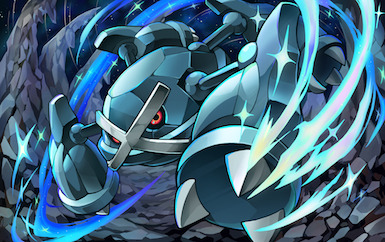
(TCG Art Competition Entry by Souichirou Gunjima)
Received as a gift from Hiyori, who decided to help Shin overpower his rival. It's very strong headed and calculated, and has an intense rivalry with *******. Shin wonders if it's the nature of how he received it that sparked their competition.
This one is a bit of an interesting pick, but will make more sense the more you know about my au. Metagross are said to have more intelligence than that of a supercomputer, and well, Shin is associated with computers along with his high intelligence. It's said that Metagross use this to critically analyze their opponents and take them out in the most efficient (and possibly cruel) way possible. If it knows it can't succeed, it's willing to even take itself out if that's the only way for victory. Shin, similarly, calculates his every move in the death game, and I don't think I need to explain the rest on why this fits.
Illuso the Zoroark
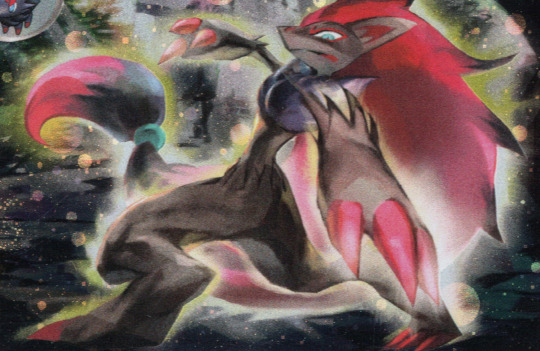
(TCG Artwork by kawayoo)
Illuso hides himself in illusions and deceit, although in reality he was a timid Zorua. After meeting Shin and accompanying him on his journey, Illuso's learned how to become more brave and outspoken. Still somewhat jumpy, Illuso delights in the tricks it pulls, as does Shin.
Zoroark is literally THE Illusion pokemon, known for putting up facades and tricking others with it's ability to hide behind illusions. Shin already exemplifies this behavior as he hides behind the facade of Sou Hiyori in the death game. Young Zorua often hide themselves behind illusions to ensure their safety, as most are very timid and weak. This pick also makes sense for another reason in my au that might come up later.
Lime the Klefki

(Fanart by Naoki Eguchi)
Shin doesn't really remember catching Lime. One day while traveling, he heard the distinct sound of jingling keys following him. After confronting it, he decided to let it join his team by giving it the key to his house. It's very sweet and likes to hang onto his belt loops. It has even tried to take the key from around his neck. He ended up making a copy of it so Lime wouldn't steal it in his sleep, and although it has no use, Lime treasures it the most.
Okay come on. The Key pokemon. Shin claiming to be the Keymaster. This one is so good. Aside from this, the steel fairy typing is very good as it's a very defensive, and Klefki is known for being a relatively good prankster pokemon in competitive. For those who don't know, prankster is an ability that allows the pokemon to move first when using moves that don't do damage, such as Spikes (sets up spikes on the opponent's field) or Calm Mind (Boosts special attack and defense). Shin tends to try and make the first move and plan ahead, setting up small advantages for himself in works of a bigger goal (such as the sacrifice card placement and his whole ordeal with getting Kanna to work with him).
Coldweather the Glaceon
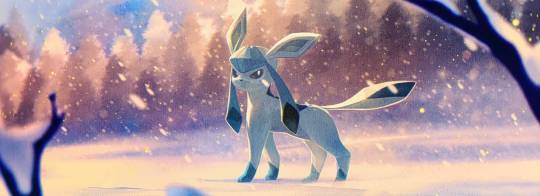
(TCG Artwork by Gemi)
Originally, Shin had been planning on evolving his Eevee into Umbreon. Though when a trip to get a gift for Kanna goes awfully bad, his Eevee spontaneously evolves into Glaceon in order to defend her trainer. Coldweather has a very calm and collected exterior, though she still loves to cuddle and play with Shin like if she were still a little Eevee. Shin is grateful for her and often ends up being the victim of her affectionate onslaught, and he appreciates her a lot. Even if he ends up having to wear 3 sweaters to hug her.
Shin is said to get cold easily, and aside from this he's known to be incredibly weak. The Ice type is notorious for being a weak typing despite having a lot of great pokemon, so I thought it would be good to pair these two up. Additionally, the plan for Umbreon was to have it represent his whole connection to the moon and the dynamic of the sun and moon he has with Hiyori. Though after thinking it over, I thought it might be interesting to have Shin go through some trial and have one of his pokemon affected by it.
Porygon-Z
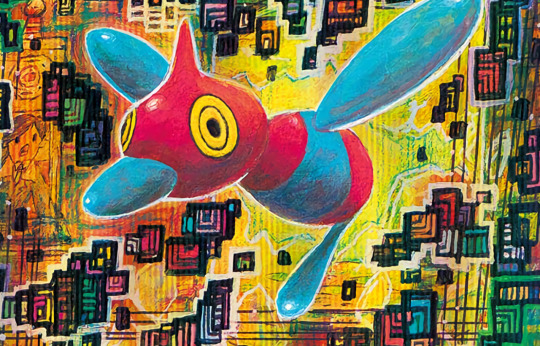
(TCG Artwork by Tomokazu Komiya)
The first pokemon Hiyori gifted to Shin. Originally Porygon was fairly neutral to Shin, acting much like a scared cat and hiding behind him when Hiyori was in the room. After evolving, Porygon2 began to show much affection and adoration towards its trainer, as it now understood speech and emotion. It helped Shin aid Hiyori in the strange research project Hiyori recruited Shin for. Undergoing many strange and harmful "training" it finally evolved into Porygon-Z. However this evolution put a strain on the relationship between the two, as Shin refused to acknowledge the corrupted mess that his beloved pokemon became. Porygon-Z was having trouble adjusting to its mutated body, but soon after began to seek the affection of its trainer once more. Shin refuses to use it, and has abandoned the idea of ever naming it.
So this one is another one that will make more sense the more you know about my au. Again, lots of complex and intricate lore. I chose Porygon to best represent Shin and his relationship with Hiyori, specifically before the death game. Porygon is a completely artificial pokemon, made up of code and only evolves when given a disk containing data. Obviously this ties in well with Shin, who learned to code thanks to Hiyori. I like to think its final evolution represents Shin's trauma and how Hiyori affected him, as it's not wrong to say that he definitely left a deep impact on Shin. Poyrgon-Z is obtained by evolving it from Porygon2 using the dubious disk, a disk containing corrupted and malicious data. You can draw the similarities (Will Shin ever reconcile with it? Well, maybe I'll explain how if anyone is curious).
Thanks for reading my rant, and if you couldn't tell, pokemon is one of my main hyperfixations. I hope you enjoyed my picks, and I'm curious to see what you think.
13 notes
·
View notes
Text
March 1, 2021: The Hobbit (Review)
Is “quaint” a good word here?

Maybe its the beautiful backgrounds, maybe it’s the stylized designs that make me think of Christmas specials, maybe it’s the faithful take on a classic story that I loved as a kid, but...I dunno. Quaint’s the first thing that comes to mind here for me, for whatever reason.
All I know is that I did enjoy this movie well-enough...even if it’s not my favorite. Don’t get me wrong, this is still a great story, and I do love the original Tolkien tale very much...but I don’t know if I can say this was my favorite adaptation or not.

Now, it got some things right that the Jackson movies didn’t, at last as far as I’m concerned. Thorin’s pretty good in this film, Gollum is great (as always), and it accurately sums up the story in a single movie without too much omitted (I do miss Beorn, though). But here’s the thing: the things that I think Jackson’s movies did wrong outnumber what this film did right.
You know, the weird addition of Tauriel and Legolas, the added Lake Town plot with fuckin’ Alfrid, the entire Azog thing, the fucking NECROMANCER thing, Rada...well, actually, I like Radagast. He was fun.

And that’s not to say that Jackson’s movies did nothing right. Quite the contrary! I mean, Martin Freeman is a PERFECT Bilbo Baggins, and basically everybody is perfectly cast, to be honest. And that includes what I think is the best part of the films: Smaug, as portrayed by Benedict Cumberbatch. And yeah, that motion capture footage is hilarious, but it pays the fuck OFF, what can I tell ya? I mean...come on.

Smaug in these movies is fucking AMAZING, and I genuinely love him. And...well, you know what, let’s actually get into the Review. Enough navel-gazing here. Here’s the Recap (Parts 1, 2, and 3), if you’d like to read that first! OK, let’s get this done and Reviewed!
Review
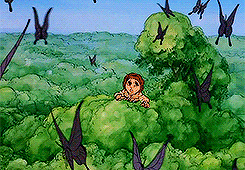
Cast and Acting: 7/10
Given that this is an animated film, this is an interesting category to grade. I’ll be doing so based on their vocal performances, and...eh. For a Rankin-Bass movie, the vocal performances are a little standard. However, that doesn’t mean there aren’t some standouts. Orson Bean plays a kind and contemplative Bilbo, and while I don’t know that I like him quite as much as Martin Freeman, I do still like his performance. John Huston is likewise good as Gandalf, although Ian McKellen is...well, Ian McKellen, even in The Hobbit films. And then...there’s Brother Theodore. And, boy oh boy, do I love his Gollum a lot! I think he’s legitimately fantastic as this version of the character, and specifically as this version of the character. Andy Serkis is still the better Gollum, I think, but I do think that Theodore handles Gollum’s last line in this film better than Serkis did. However, I can see Serkis becoming the devious little monster he eventually becomes a lot more.
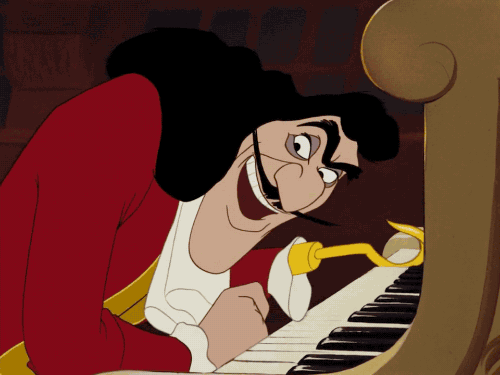
Also, Hans Conried plays Thorin, and all I could hear was Captain Hook, like, the entire time. There are actually a lot of voice actors from the time period in here, like Don Messick, Paul Frees, and Thurl Ravenscroft, and they’re all fine. There’s also Richard Boone as Smaug, and...he’s OK. Not saying he’s great, but...he’s all right. His deep booming voice does work well for the role, and some of his line deliveries are pretty goddamn solid, but...I dunno, he just doesn’t bring the same gravelly gravitas that I expect of, well, a goddamn dragon, let’s be frank here.

Plot and Writing: 9/10
What can I say? It’s Tolkien! And they’re pretty exact with their adaptation of the original work, as adapted and written by Romeo Muller. And yeah, Muller does a good job...but he also writes this similar to how he wrote all of the other Rank Bass specials. If there’s any problem, it’s that. But even then...I don’t know if I can call that a real problem. Still, I’ll take a point off for it, even though it’s really closer to half a point. If anything, I’m upset that Beorn was completely absent. You coulda worked him in, Romeo!
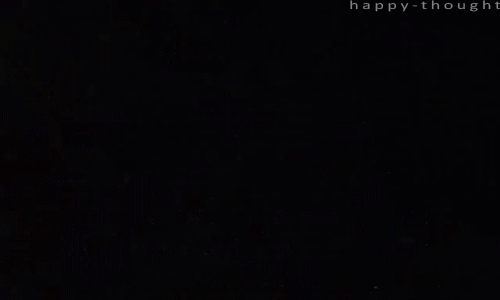
Directing and Cinematography: 7/10
This is essentially judging the storyboarding, and how shots were positioned in the artistic process. And yeah, it’s...mostly good. Unfortunately, true to form for Rankin-Bass production, it often feels just a little too stiff in places. Makes sense since Arthur Rankin Jr. and Jules Bass are the directors. Not as bad as some of their other productions, but still definitely a notable quality of the film. So, points off for that, but the rest of it is honestly fine, especially for animation of the era. What came out from Disney that year?

Oh, damn, the Rescuers? Yeah...shit, yeah, that looked WAY better, and that wasn’t even one of Disney’s best looking film up to that point. Although, different budgets should probably be taken into account. OK, moving on.
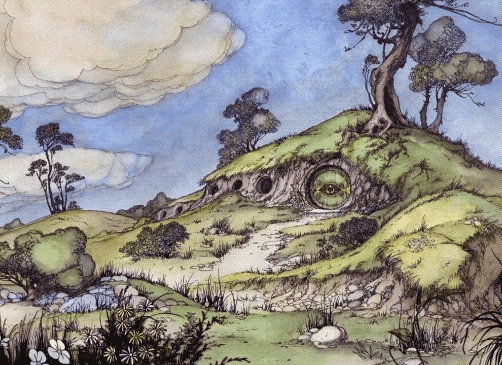
Production and Art Design: 8/10
I like the backgrounds in this film a LOT, lemme tell you. They were done by Minoru Nishida, who’s done a hell of a lot of animation stuff, but was also the art director for Kill Bill Vol 1! Neat! But yeah, the backgrounds are absolutely gorgeous here. How about the rest of the art design? Characters were designed by Lester Abrams, then redesigned a bit by the Topcraft guys (specifically Tsuguyuki Kubo), giving it the very stereotypical Rankin-Bass style that the movie is known for. And does it work? I mean...kinda. The good news is that the different races of Middle Earth are pretty goddamn distinguishable from each other, and creatively designed at that. The bad news...sorry, I never did get used to Smaug, I genuinely don’t like his design in this. Like...why the dog head? By all accounts, Smaug was a stereotypical wyrm-style dragon, with the reptilian features and I. I just...I don’t get it. Sorry, but Jackson’s Smaug wins here, hands down. But that said...I do like Gollum. It’s different, yeah, but I think his design works pretty well. After all, according to Tolkien, we’re not really supposed to know what Gollum is. And I think it works pretty goddamn well!
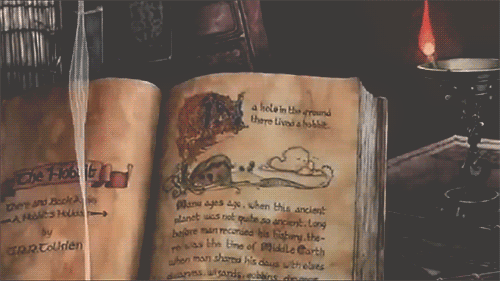
Music and Editing: 7/10
Glenn Yarbrough. I love ya. I SWEAR, I do actually like you and your main contribution to this movie, The Greatest Adventure. But if I have to hear that song ONE MORE GODDAMN TIME in this movie, I swear...because they chop up the song and use it in EVERY AVAILABLE INSTANCE with Bilbo. And I guess it’s his leitmotif, but they use that song...A LOT. And not instrumentally, I mean with the goddamn lyrics. Just...tone it down a little, OK? But OK, what about the other music, by Maury Laws? I like it! There are some songs in here that are very catchy, and I might actually get “Down, Down, to Goblin Town” on my playlist. Not that it’s all great, but it works for the setting and for the tone of the movie. And what about the editing? Eh. Visual editing is pretty good, bu7t the sound editing is...it’s 1970s animation editing. Hell, even the Rescuers sound editing wasn’t amazing, when I think about it. It’s fine, but it isn’t great most of the time.
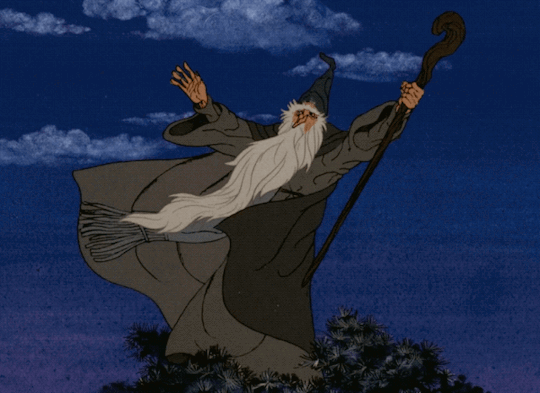
Y’know...I think I can gel with a 76% here.
Yeah, I know, it’s low, but that’s because this movie was...good, but OK. I’m not necessarily saying that it was better or worse than the Jackson movies, because I think they compliment each other in some weird ways. I like Thorin as a character more here, but Smaug MUCH more in the Jackson films. While there definitely don’t need to be three Jackson movies...I’ll admit that I think this one is too short, coming in at only an hour and 18 minutes. And I gotta say, I love the fact that it’s animated...but the live-action films also look fantastic, I can never fault them for how they look (except for Dain...ugh). I think they’re similar, but different, at least for me.
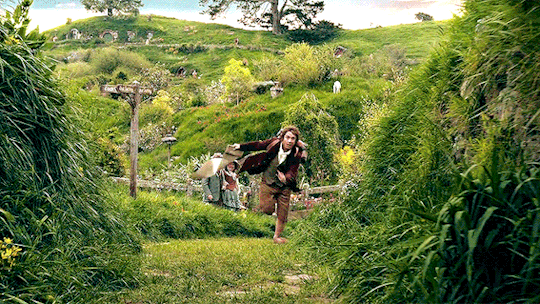
But OK, here’s a question: is it just because it’s a property that I really like, and I have my own internal vision of it, which might be influenced by the live-action films? Entirely a possibility. Watch this movie yourself, make your own score! See what you think. Meanwhile, I’m going to try an experiment.
Fantasy movie, same production company, same directors, same animators, also based off of a fantasy book. And, uh...I dunno, a unicorn, maybe?

March 2, 2021: The Last Unicorn (1982)
#the hobbit#the hobbit 1977#j.r.r. tolkien#rankin-bass#rankin bass#orson bean#bilbo baggins#hans conried#thorin oakenshield#john huston#gandalf#otto preminger#cyril ritchard#glenn yarbrough#fantasy march#user365#365 movie challenge#365 movies 365 days#365 Days 365 Movies#365 movies a year#userakaysa
23 notes
·
View notes
Note
ohh I read your tags on that one nishiki meme post,, I felt like I was hit over the head with a bicycle broo
AUTHOR is that you??? Hello!
Waait you wrote Fugue? And all the other ones??
Also you hhh you run at least one meme blog on both jojo and yakuza??? Dude I don’t know how to tell you this but you’re literally everywhere. I appreciate you!
I might just review the Nishida one soon, although I just unlocked the construction thing in kiwami 2,, and that’s pretty much where he appears.
Anyway this would be embarrassing if I were wrong but I’m pretty much 90 percent sure according to the tags on the “made-up character” post;
I wanted to say hello to you at LEAST, most of the Nishiki simp posts were made by you and I can relate. (Although I probably shouldn’t follow you because spoilers, huh?)
In other news, I’m drawing a comic about why Tonight -restart from this night- is singable all the way to Yakuza 6 (apparently?) and Judgement’s only in 0. No WAY a place focused on karaoke would only have seven songs or so!
I think that the characters only sing songs that they want to sing, meaning that Judgement could very well be there. (Confirmed by inviting Majima, where he sings songs that aren’t on the list)
What would happen if Kiryu were to sing it again? Would he be able to?? (Would he hear Nishiki’s voice even though he’s not there like in 0?) By the radio station substory it’s confirmed that Judgement is Kiryu’s favorite song so it wouldn’t make any sense unless,,
“As always, Judgement’s my song!”
maybe he can’t bring himself to sing Judgement because yknow—
Maybe it wasn’t only—
Again, I can’t get Y1 Japanese Kiryu’s heartbroken voice out of my head and that’s part of the reason why the comic’s gonna be like three/four pages instead of three panels.
Will I finish it this week? No. Will I finish this month? Probably not. Last one page comic I did took three years but I wasn’t that motivated to do it.
ANOTHER THING (and I hope I’m not bothering you, guess all my comments are ultra long sorry) you ever notice that Kiryu avoids most fights except the heat action tutorial in Yakuza 0?
Yeah so that was because one of the drunkards hurt Nishiki a little bit. NO FOR REAL look at that scene it’s really quick, but the younger drunk pushes the older into his kyodai.
(Also probably why he threw a punch at Awano despite his rank;;)
Okay I’m gonna go now before this gets any longer buh bye
AND I APPRECIATE YOU !!! I’ve still been thinking about your comment, and I’m glad we found each other here!
As for following me, I try to be careful about tagging “yakuza spoilers” and also sometimes specifically per game. But if you want to avoid spoilers entirely you should def avoid “yakuza spoilers”. But also i will not harbor any hard feelings if you unfollow until youre fully caught up :)
I agree on the karaoke songs being the songs a character would choose to sing. And as for why kiryu won’t sing judgment after y0, I think you’re likely also correct that it’s because he won’t sing without -
it’s a duet, how could he sing it without -
ANYWAY! happy to find you and PLEASE PLEASE show me your comic whenever you are ready!! it sounds delightful and I’d love to see it
3 notes
·
View notes
Note
39/43 Kazumaji This shits hard because I don’t wanna send shit I can answer myself.
Well, we could write better questions xp Or you could trust your wife to make things interesting xp [Ask list here]
39. Who leaves little notes in the other one’s lunch? (Bonus: What does it say?)
I cannot imagine any yakuza taking their lunch to work, for reals. And Kiryu’s other job is stay-at-home dad so his lunch is already at his work? But Majima’s other job is construction and construction workers bringing their lunch to work is a thing, so we’ll pretend this is the Good Timeline where Kiryu didn’t fuck off to Okinawa and instead stayed in Majima’s custom fortress in Kamurocho.
In that timeline, Kiryu gets in the habit of making bentos for all his children before he sends them off to school and one day he decides to just make one for Majima too. Majima had said something about having a long day so Kiryu figures he might not have time for lunch otherwise. Rather than let his hus- uh... boyf- mmm... roommate starve, he packs him one too and sneaks it into Majima’s suspiciously empty toolbox. The first one has no note as Kiryu had only just thought of doing it.
Of course, by the time the lunch hour rolls around, Kiryu had almost forgotten he did it until he gets called my Majima three times in a row and assumes it’s important. He picks it up to hear Majima screaming, “YOU MADE ME A BENTO!?!” through a mouthful of rice.
Kiryu has to stop and rubs his neck awkwardly. “Well, yeah, you said you were going to be busy and-”
“THANK YOUUUU KIRYU-CHAAAANNNN!”
Kiryu cringes, holding the phone away until the tinny scream stops. “Y-You’re welcome, Majima.”
“You’re so good to me, Kiryu-chan, what can I do to repay ya?”
Kiryu flushes, but thinks for a bit. “Well, if you don’t come home too late, I can make you dinner too.”
Majima growls, “That’s not something I can do for ya, that’s something you can do for me!”
“Yeah, I guess it is,” Kiryu sighs, searching his mind fruitlessly for something else to say.
Majima bails him out. “I’m real touched, Kiryu-chan,” he murmurs in his normal register, “I’ll think of something nice for ya.”
Kiryu flushes harder. “You really don’t have to-” But Majima’s already hung up. This is why he made a policy of not answering Majima’s calls. They were always somehow worse than talking to him in person.
After that, Kiryu just gets in the habit of making an extra bento. He’s already making a dozen each day, what’s one more? And he doesn’t admit to making Majima’s extra pretty, making sure the fish and nori lay just so in the box or buying those fancy tweezers just so he can make little bunny ears in the rice balls.
One day, Majima leaves too early for Kiryu to give him his lunch. Disgruntled, Kiryu grabs some scratch paper and writes “You work too hard” on it, tapes it to the bento and marches down to the construction site to hand off to Nishida. It’s only after he makes it all the way back home that he realizes he put a little heart on it too.
43. What is the first thing that changes when they realize they have feelings for the other?
Ohhhh mannnnn. See, now that’s an actually hard question. There are still some good questions to be had.
Well, the first thing that changes for Majima is he has two whole reasons to be alive now. And that’s a 100% increase, so that’s pretty good. Living just to have your brother kill you is not so hot. Living so you can see what this beautiful boy becomes is a bit better. But seriously, Majima takes one look at Kiryu and it’s over for him. He immediately decides this man is part of his destiny, part of his future. And that’s wild because Majima has spent a long time believing he has no future. And he still mostly is waiting to die, but... Kiryu’s a pretty sweet thing to be a part of until then. He hates himself a little less when he’s with Kiryu. Maybe that’s why he follows him around so much.
Kiryu is a little harder. He didn’t realize he was in love with Majima until he couldn’t bear to exist without him. But that doesn’t mean their weren’t unconscious changes before then. The first thing that changes is, unlike with any other opponent, Kiryu doesn’t have to spend time analyzing weaknesses, debating a fight, trying to decide is friend or foe. There’s no deliberation, Kiryu just knows. That’s a friend and they’re absolutely going to fight and there are no weaknesses. Sure there might be an opening during the fight, the odd spot Majima leaves unguarded or, heaven forbid, a strength contest that Majima will lose 10 times out of 10, but... it’s not like meeting someone with a bad leg, or surrounded by weaker players, or carrying a weapon. All those people you know how they’ll move, what they’ll favor and what they’ll avoid. But Majima is versatile and unpredictable and he takes up all of Kiryu’s attention every time. If he doesn’t have all of his focus on Majima, he’ll get fucked and he knows it. There’s never any question with Majima. And that’s unlike anyone else Kiryu comes across.
When Kiryu does at last realize he’s in love, the first thing that changes is all the weirdly strong feelings around Majima suddenly make sense, the implicit loyalty, the amusement, the fact that he’s never surprised when Majima is there to help him. And the first thing he does is go to him. When Kiryu knows, his first reaction is to admit it, to just say it. He’s changed so much already in the time he’s known him, the only thing left is that.
#sorry this was late#hopefully worth it#KazuMaji#ask meme#Kiryu Kazuma#Majima Goro#amaranthineexcuse
18 notes
·
View notes
Text
Translation: The Television: BEYOOOOONDS’ 66 Pairs!
In The Television, they had each member of BEYOOOOONDS talk about the rest of the members in the group, their impressions of them, or a fun story. I translated all of Utano’s about the other members! Enjoy, and please don’t repost without credit!
Satoyoshi Utano -> Shimakura Rika I really talk with Rika-chan often. Since we're the same age, we make plans to go out together, and the two of us also stop by cafes. I was surprised to find out that we have a mutual friend, and since we have something like that, I think that's why I talk to her the most.
Satoyoshi Utano -> Kiyono Momohime Hime-chan's dancing is sharp when she is performing, and she has a charm that makes you say, oh!... However, she has energy and cuteness that is appropriate for her age, so she has that gap moe. She really completely changes, and I think that's really attractive.
Satoyoshi Utano -> Maeda Kokoro No matter what, she's full of care and kindness. For what we don't know, she'll tell us about it before we mess up. When I went somewhere for the first time, she contacted me like, "you know where you're going?" She doesn't feel like a younger person, and she spoils me, and it feels like she'll always wrap me up gently.
Satoyoshi Utano - > Nishida Shiori Shiori-chan is three years younger than me, but she's really mature. She calmly looks at her surroundings well. Even when we just joined, she taught us like, "you do this here," and from the beginning there really wasn't a wall between us. She is really kind and attentive, and I think many times that I would like to learn from her.
Satoyoshi Utano - > Okamura Minami Miimi-chan is probably the personification of cute. I want her to be my sister. At first, I was wondering how I could reduce the sense of distance between us, and we watched the same Disney Channel shows and cartoons when were young, and since we had the same likes, we gradually became friends. The other day, I did Miimi-chan's makeup, and she happily said, "it's like magic!" It was really cute. I want to pat her head like, good girl.
Satoyoshi Utano -> Yamazaki Yuhane Yuha-chan gave me my nickname of "Uutan!" When I was nervous at our first shoot, she said to me, "is it okay if I call you Uutan from now on?" And that made me really happy. So, I think that I want to treasure this nickname. We were shy at first, and both of us were like "ah..." but, we played around and became closer, and ow I think the distance between us has really shrunk. We talk like, "next time, let's go hang out, okay."
Satoyoshi Utano -> Eguchi Saya Saya-chan is BEYOOOOONDS' ball of energy! She's from Kansai, and she's really funny, and giggly. She is younger than me, but she did activities as a Hello Pro Kenshuusei, so at first, there was a feeling of confusion on how to approach her. But, since the start, we've been close, and she understands me well, and that makes me really happy and grateful!
Satoyoshi Utano -> Kobayashi Honoka Honoka feels like, washoi! Though she looks mature, she's energetic and can't be brought down. Miyo is the type who really thinks, and when I'm worried, she teaches me what to do but, as for Honoka's nature, she has courage. Since she loves music, enjoying music is the most important thing to her, and I have the image that she is the closest to music. Since music is her favourite, it gives her confidence and courage, and she really has the atmopshere of being like, let's do this. It also gives me power, and I think, let's do our best.
Satoyoshi Utano -> Takase Kurumi Kurumi-chan is BEYOOOOONDS's mom (laughs). She pulls the group a long, and when we mess up, she says, "next time, do it like this," or, "it'd be good if you were careful here." Since I have the personality of a sister, I have the strongest image of her pulling me along like, "over here, this way!"
Satoyoshi Utano -> Hirai Miyo Miyo knows a lot of things, but I think that she's a person who is really thoughtful. She thinks about a lot of various things, and she'll always tell me what she thought. In fact, that really makes me happy, and is needed. I have the impression that she looks at things objectively, and when she says, this is good, you can feel the raison d'etre. The way she words things is very polite, and her sensibility is rich. She feels like an adult.
Satoyoshi Utano -> Ichioka Reina Reina-chan is the first member that I hung out with. Reina-chan invited me like, "do you want to go here and have cake together?" She's two years older than me, and after all, she's mature. However, sometimes, she has points where she's airheaded, and that's also a charm point. It's gap moe.
0 notes
Text
On breath-image and the terminality of sound
This is a text that accompanies my new piece breath-image, which will be performed next month in Vilnius, Lithuania by Ensemble Synaesthesis. ______________________________________ One of the main questions running through my recent work is that of emptiness and the radically unrepresentable, and how these categories can be mobilized through an experiential praxis in the field of aesthetics. Allow me a very brief primer now. We are living under a tyranny of representation, and a severe limiting of imagination and utopian thought. We are all of us, at bottom, utopians. We all have dreams for the future, and we all would like to see a world different from the one we have now. A better world, regardless of one’s particular political inclinations. However, to conceive of utopia means to conceive of something that is, by definition, radically unconceivable. Consider this: if we could imagine utopia, would it not instantly become a mere conceptualization, a representation of what we think utopia would look like? Would this representation not arise strictly from within the confines of what is, at present, imaginable? If this is so, such a conception of utopia would conform to what our current ideological or discursive moment defines as the limits of possibility, inherently negating its radical nature. This tyranny is effected on us not from without—not from some unseen “above” from which the “powers that be” control what can be thought. No, this tyranny arises from the very structure of logical thought itself. It is marked by a rupture at the very beginning of thought that permeates every subsequent thing with its primordial broken-ness. Consider the traditional rules of logic, as condensed by Bertrand Russell: the law of identity, or “whatever is, is”; the law of non-contradiction, or “nothing can both be and not be”; and the law of the excluded middle, or “everything must either be or not be.” Now consider the process of perception as it occurs in real time. Whenever an object—a sensation, a sound, an image—is perceived, it is first perceived just as it is. In that first moment of apprehension, there is no conceptualization, no naming, no categorizing, and no difference. The laws of logic have not arisen yet and what is apprehended both is and isn’t, at least in that very first moment. It is only later that the logical mind intervenes to counterpose the perception of the object against previous sense perceptions stored in the memory in order to identify it—this is, after all, the way in which we come to know that the color we are seeing is blue and not red. But, most crucially, it is at this moment that the distinction first arises between subject and object, between the seer and what is being seen. Why is this important? Allow me to be crude for the sake of brevity. It is entirely in the first moments of this operation of deliberative discrimination that the foundations are laid for all the suffering, injustice, and oppression that afflict us. Or rather, it is only in the moment that precedes conceptualization—what Japanese philosopher Kitarō Nishida calls “pure experience”—that true liberation can arise. Simply stated, the first decision—the decision to differentiate—solidifies and reifies conceptions of difference that are, in the deepest sense, mere mental constructs. Taking it, again quite crudely, into the realm of the everyday and the sociopolitical, isn’t it true that it becomes easier to oppress someone, to silence their voice, if one regards oneself as separate or different from them? True compassion can arise when this difference is pierced and seen as the illusion that it is. It is at this juncture that the work of critical thought is revealed, particularly as it relates to philosophy and art. Even at the surface level of specificity, we know that the role of critique is to prod at ideas and constructs that appear in everyday thought to be solid and unchangeable. As Marx famously wrote, “all that is solid melts into air.” Indeed, the rich tradition of critical theory inaugurated by Marx’s own thought is built on the idea that the first step towards emancipatory thought is to reveal the houses of cards upon which we build seemingly stable systems of ideas, from the philosophical to the interpersonal. This is where the most crucial work of philosophy can begin: to reveal the fluidity and ephemerality at the base of the gargantuan superstructure (to borrow Marx’s own terms) in order to more clearly see through the veils of ideology. To more clearly see things as they are. But the most radical of Marxist thinkers are not content with simply showing the illusory nature of most of our widely-held assumptions. For those who are willing to go ever further (I think here of people like Lefebvre, Rancière, Deleuze…) to open the door to true emancipation means opening the door to a complete deconstruction of even the most basic operations of thought—ultimately, to open the door to the unthinkable, that which resists conceptualization and representation, both verbal and aesthetic. This leads us back to that first ontological decision to constitute a subject that is separate from what it observes. Here is the true power of philosophy and critique: to follow the operations and lines of questioning that critical thought lays out in a thoroughly engaged, honest, and self-reflexive way means problematizing one’s position at every turn, and it must inevitably lead to the collapsing of the idea of a separate, fully constituted self in the name of radical liberation. Paradoxically, it is through logical thought that philosophy arrives at and actualizes the experience of non-dual awareness. As such, it could be thought of as an indirect path to it. Through progressively more profound questioning, philosophy opens up the possibility of, ultimately, doing away with conceptualization itself. But there is also a direct path to pure experience. In contemplative traditions, it takes the form of meditation—observing mental processes and expanding one’s awareness to fully encompass experience and perception before they enter into duality. But art, and music in particular, can accomplish the same thing. In a very real sense, the way in which meditative practices and aesthetic expression reveal pure experience is infinitely more powerful than the intellectual approach, precisely because the knowledge is apprehended existentially at the ground of being. It arises experientially, devoid of verbal associations or concepts. Pure sound, more than any other artistic medium due to its fundamentally non-discursive nature, is particularly well suited for opening these non-discursive and non-conceptual fissures in thought. Where deep listening is allowed to occur, deliberative discrimination necessarily ceases. breath-image is concerned with two primary questions. The title is taken from François Jullien’s book The Great Image Has No Form, or On the Nonobject through Painting. In his book, Jullien examines the idea of the nonobject, or the undifferentiated, through the lens of various classic treatises of Chinese painting, as well as the Tao Te Ching. He compares the dominant drive in Western art, that of individualization—the object that ‘reveals its essence as each motion of the brush specifies it […and] gradually eliminates all other possibilities of being until it makes the object appear as if that object could be nothing but itself’—with that of Chinese painting, which revels in the undifferentiated, the indistinct, and the evanescent. The concept of the breath-image, as Jullien writes, comes from the writings of Wang Wei. He writes: “When you contemplate painting, you must look first at the breath-image. […] Apprehension [...] proceeds from the more general-evanescent to the more tangible and rigid. Landscapes are great things. When we look at them, we must place ourselves at a distance to contemplate them. Then only do we perceive, in a single sweep, the breath-image emanating from the tension-forms of the landscape. […] At the lowest level are forms, the most tangible level but the most limited in effect. Then come the tensions that permeate them, conferring dynamism and vitality on them. Finally there is the breath-image emanating from it overall. The breath-image breaks free from the mire of forms and unfurls figuration beyond figuration, or rather upstream from it, opening it to the undifferentiated and making it available as the "great image.” The music follows the line of questioning arising from the idea of a breath-image. How and where does form emerge over time from the undifferentiated fount of pure sound? This question is asked not only in regard to large-scale form emerging over the span of the entire piece, but also of the smallest spaces within the sound itself—its “inbetween-ness”. Can forms emerge there? This is the spirit of the question asked in the final page of the piece: Where is the sound blooming? What about the locus of the unfolding of this sound? Where does it bloom from? This inbetween-ness—not only the spaces between the sounds, but the spaces within the sounds—is at the heart of the second line of questioning. Sound is a unique representation of the physical world in all of its impermanence. Every single sound is at once permeated with the seed of its own cessation: silence. Sound arises and passes away at every moment, and as Stewart Cox writes, ‘it deserves special status insofar as it so elegantly and forcefully models and manifests the myriad fluxes that constitute the natural world.’ The fact that sound is constantly enveloped by silence constitutes its terminality, in the sense of a terminal disease. Eric Cazdyn describes terminality as a positioning of the future as ‘that which is already included in the present, while maintaining it as that which is radically separate from the present.’ So indeed, while all sonic phenomena as they occur naturally present a fruitful opportunity to contemplate terminality and impermanence in their passage from audibility to silence, the provocation I wish to present is that we can contemplate the silence contained in sound already from its emergence. As such, breath-image revels in the idea of terminal sound—the fragile, the subtle, the barely audible—but also in the idea that terminality flashes through from within all sound, even—no, especially—that which seems at first most stable.
1 note
·
View note